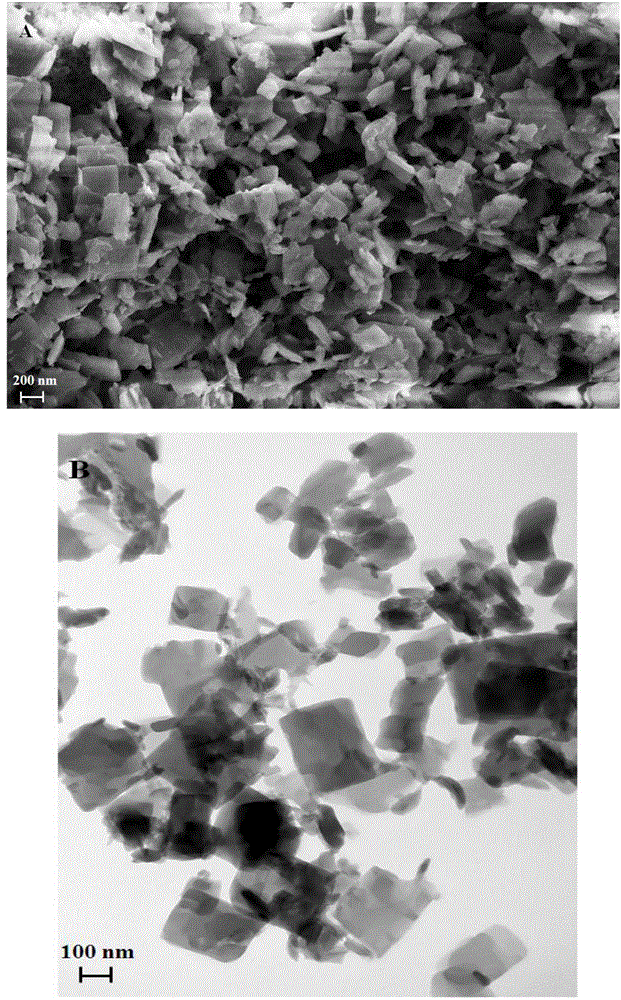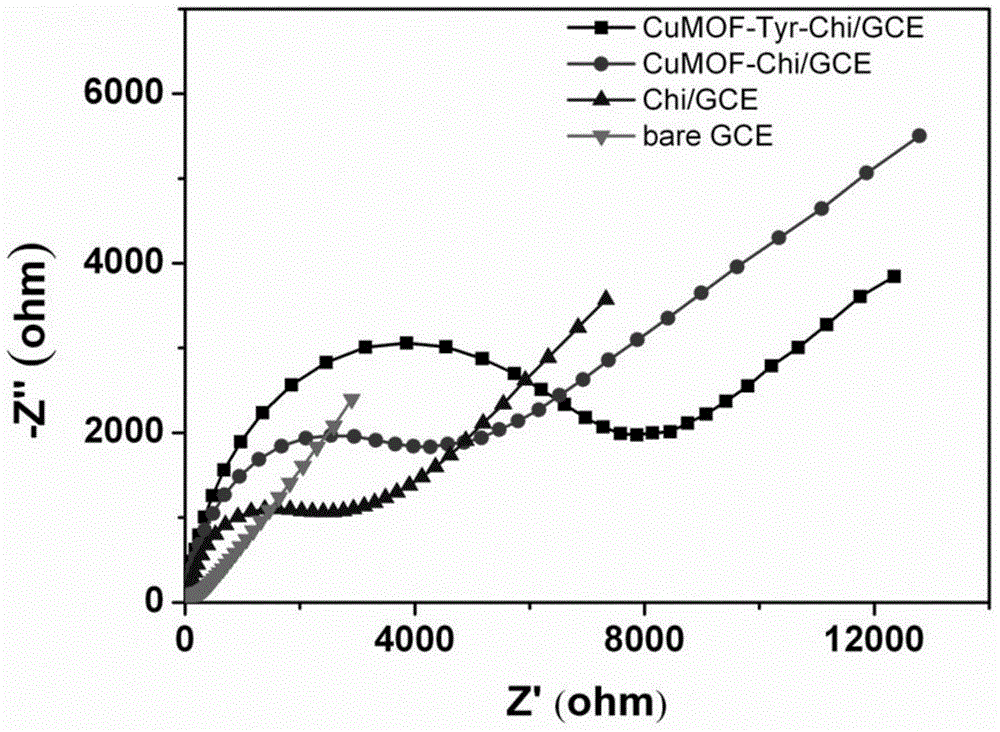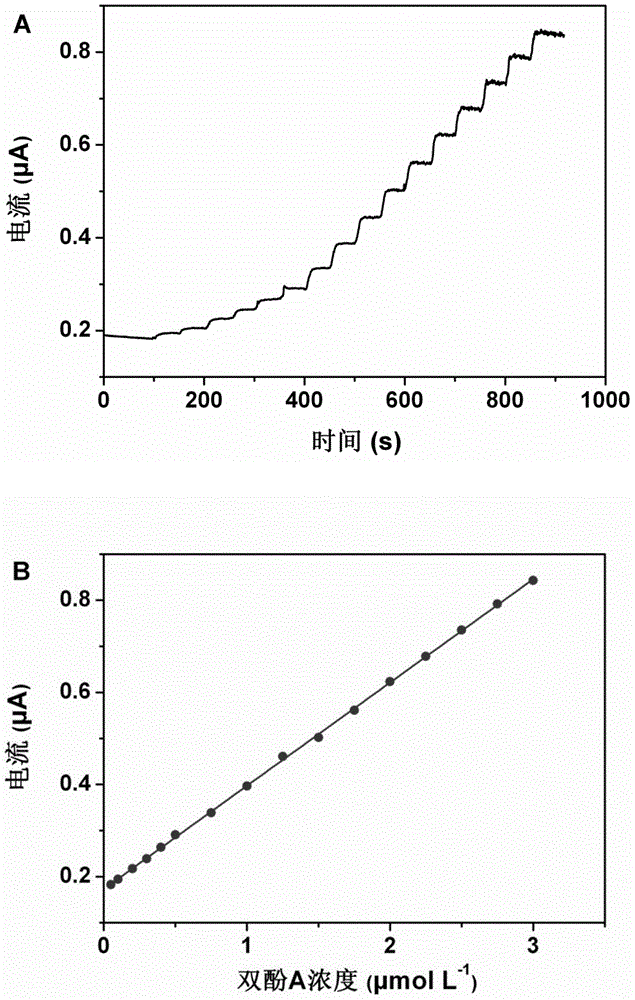Biosensor based on metal organic skeleton material and application thereof
A metal-organic framework and biosensor technology, which is applied in the field of biosensors to achieve the effects of rapid detection response, improved sensitivity and high selectivity
- Summary
- Abstract
- Description
- Claims
- Application Information
AI Technical Summary
Problems solved by technology
Method used
Image
Examples
Embodiment 1
[0045] Example 1. Preparation of tyrosinase electrochemical biosensor
[0046] Glassy carbon electrode assembly steps:
[0047] (1) Polish the surface of the glassy carbon electrode with aluminum oxide powders with particle sizes of 1 μm, 0.3 μm, and 0.05 μm, and then repeatedly ultrasonically clean it in anhydrous ethanol and deionized water, and then dry the electrode surface with nitrogen gas. use. Put in 1mmolL -1 Potassium ferricyanide / potassium ferrocyanide solution (molar ratio 1:1) at -0.1 ~ Scan the cyclic voltammetry curve between +0.6V. The redox peak potential difference of the curve is less than 70mV, indicating that the redox reaction on the surface of the glassy carbon electrode is a completely reversible reaction, and the electrode polishing is in good condition, and the next experiment can be carried out.
[0048] (2) Preparation of metal organic framework material-tyrosinase composite material. Metal-organic framework material was added to tyrosinase pho...
Embodiment 2
[0051] Example 2. Electrochemical Characterization of Tyrosinase Electrochemical Biosensors
[0052] On the PGSTAT302N electrochemical workstation, the CuMOF-Tyr-Chi / GCE, CuMOF-Chi / GCE, Chi / GCE and bare GCE prepared in the above example 1 were respectively measured in the presence of 1 mmolL- 1 Potassium ferricyanide / potassium ferrocyanide (molar ratio 1:1) probe and 0.5molL- 1 AC impedance signal in electrolyte with potassium nitrate supported electrolyte. Experimental results such as figure 2 As shown, the order of charge transfer resistance of different modified electrodes is: CuMOF-Tyr-Chi / GCE>CuMOF-Chi / GCE>Chi / GCE>bareGCE, indicating that the CuMOF-Tyr-Chi composite material in the present invention has been successfully modified in Electrode surface, successfully prepared tyrosinase electrochemical biosensor.
Embodiment 3
[0053] Example 3. The standard solution for detection of bisphenol compounds by tyrosinase electrochemical biosensor
[0054] Add a certain volume (0.4-2μL) of bisphenol A standard solution (1mmol / L) continuously dropwise (once every 50s) to the detection solution of the three-electrode system composed of tyrosinase-modified glassy carbon electrodes, 8ml of phosphate buffered saline In the solution, under the situation that working potential is-0.1V, carry out potentiostatic scanning, the current-time (I-t) relationship curve that obtains, because the bisphenol A concentration in the detection solution in the fixed time point in I-t curve is known, so can obtain Correlation curve between current intensity and bisphenol A concentration. In the presence of oxygen, tyrosinase catalyzes bisphenol A to generate o-phenolic compounds, which are further catalyzed to generate o-quinone compounds, which are then reduced to o-phenolic compounds at a lower potential. The tyrosinase elect...
PUM
 Login to View More
Login to View More Abstract
Description
Claims
Application Information
 Login to View More
Login to View More - R&D
- Intellectual Property
- Life Sciences
- Materials
- Tech Scout
- Unparalleled Data Quality
- Higher Quality Content
- 60% Fewer Hallucinations
Browse by: Latest US Patents, China's latest patents, Technical Efficacy Thesaurus, Application Domain, Technology Topic, Popular Technical Reports.
© 2025 PatSnap. All rights reserved.Legal|Privacy policy|Modern Slavery Act Transparency Statement|Sitemap|About US| Contact US: help@patsnap.com



